Red hydrangea: varieties, selection and cultivation

Hydrangea is the type of plant that can decorate any territory with its decorative effect. Many gardeners mistakenly consider the red shrub to be whimsical and difficult to grow.

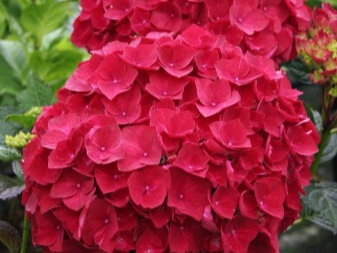
Types and varieties
China and Japan are considered the birthplace of hydrangia. This garden representative of flora does not exceed 140 centimeters in height. The color of red hydrangea buds can be different, depending on the composition of the soil. Inflorescences are both pink and fiery red.
Remontant types of culture are currently considered especially in demand, since they are capable of blooming not only on last year's, but also on new shoots.

The following is a description of the main varieties of red hydrangea.
- Red baron Is a perennial flowering shrub. It is appreciated for its high decorative qualities and endurance. This border representative of the flora has flowers consisting of 4 petals. A special feature of Red baron is considered to be crimson-pink flowers with a greenish core. The flowering phase of this culture falls on the period from July to September. The plant prefers a neutral soil, as well as an area that is relatively protected from sun and wind.


- Red angel is a large-leaved hydrangea that can reach a height of no more than 100 centimeters. Last year's shoot has a lignified state, the young one is herbaceous. This spectacular variety is characterized by the presence of exquisite pink-red inflorescences. The decoration of the plant is its black and green leaves. Good water availability is beneficial for crop growth in a well-lit area. The shrub prefers fertile, drained soil, but does not tolerate limestone. The height of the hydrangea reaches 100 centimeters, the indoor representative is 60 centimeters.

- Red Sense. Under natural conditions, the shrub can grow up to 400 centimeters, but in private plots its height is no more than 100 centimeters. The globular inflorescence of hydrangea can be colored white, blue or pink. The bud diameter is usually 20 centimeters. The flowers of the culture are characterized by double, semi-double and simplicity. The petals are often simple, but there are corrugated and jagged ones. The Red Senseion flowering phase begins in July and ends in August.

- Hot red. This short, large-leaved hydrangia is a lush shrub with red buds. Hats with collected flowers have a diameter of about 15 centimeters, they stand out beautifully against the background of dark green foliage. For 1 season, the plant can increase in height and width by 20 centimeters. The optimal site for the development of hydrangeas is one that has moist soil and is protected from the wind. The culture blooms luxuriously from June to September.
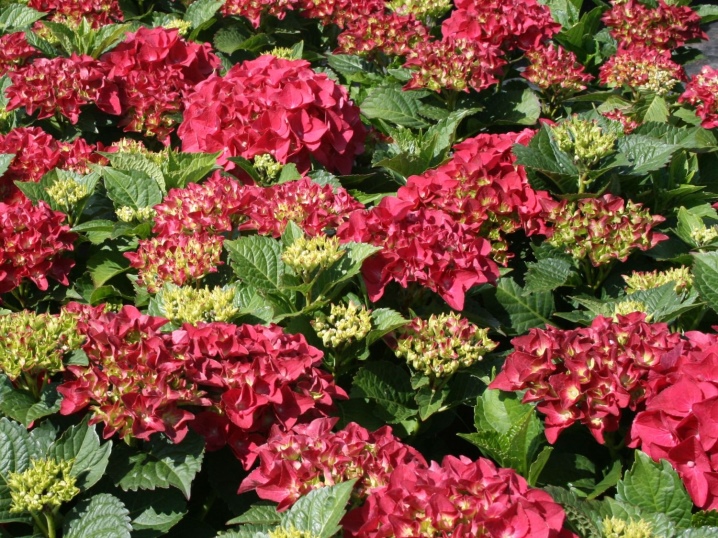
- Royal red. Hydrangea is characterized by an early flowering phase. Each of her flowers has a diameter of 20 centimeters. The color of the buds depends on the acidity of the soil in which it grows. This variety is compact, its height does not exceed 10 centimeters. The shape of an adult plant is spherical. Royal red should be planted in a semi-shaded area that is protected from direct sunlight.

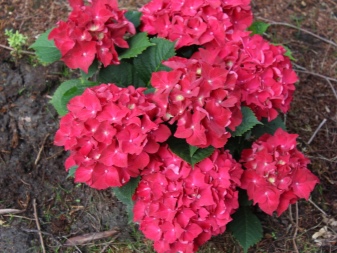
- Wim's red - one of the most beautiful varieties of hydrangea. In adulthood, the plant has a paniculate, erect, dense culture.The height of a representative of the flora can reach 150 centimeters. During the flowering period, hydrangea pleases with the presence of cone-shaped inflorescences 0.3 meters long. The color of the buds ranges from white to wine red. In this phase, Wim's red exudes a pleasant honey aroma.
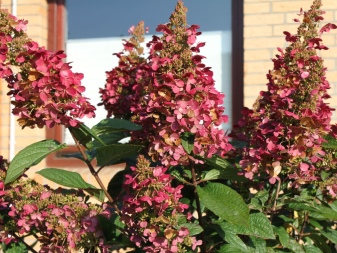

How to choose?
Before choosing a hydrangea, you need to decide on a place for its future planting. The varieties of this plant that are commercially available today can be characterized by different levels of frost resistance. This factor should be taken into account and a plant should be selected in accordance with the climatic characteristics of the territory.
If there is not much space on the site, then panicle red hydrangea will be the best option, since most of its varieties do not exceed 100 centimeters in height.

And also it is worth paying attention to the decorative qualities of the culture, because it is thanks to them that the plant will be able to decorate the territory.
When choosing a place for planting hydrangeas, you should not stop in the area near the path, since fragile shrub twigs are prone to breaking off. It is impossible to single out the best among the varieties of this representative of the flora, each is beautiful in its own way. Therefore, when thinking about choosing a culture, you should be guided by personal preferences and characteristics of the plant.



General rules of planting and care
Planting red gortesia in the open field should be carried out in early spring or autumn. It is preferable to do this in the spring. A very important point in this procedure is the choice of location. The culture needs an acidic, well-moistened soil. Illumination in this case is not important, since the bush grows well in partial shade and in a sunny area.


Consider the stages of planting a plant.
- A hole is dug, the depth of which should be from 0.4 to 0.5 meters, and the width - 0.4 meters. Provided that there are small hydrangea processes, the hole is made with smaller dimensions.
- A substrate is being prepared, which should include fertile soil, humus, peat. Adding 50 grams of mineral fertilizers will not harm this mixture. The prepared substrate must be left in the well for at least half a month. In the case when the soil on the territory is fertile, it does not need to be prepared in advance.
- The planting material is installed in the center of the hole, while you should not deeply deepen the root collar of the bush. It is necessary to pour soil around the seedling and tamp it. Thus, the root system will be well pressed, without voids around it.
- After planting, hydrangea must be watered abundantly. It is also recommended to sprinkle it with sawdust, bark, peat.
- When all of the above stages are completed, it is worth covering the young plantation from direct sunlight for several days. Thanks to this event, one can count on the rapid establishment of the culture. Planting a red hydrangea can be either single or group. Gardeners should keep a distance of 100 centimeters between flora representatives.




It is necessary to care for the crop correctly, while it is important to regularly water and feed the plant. With good care, hydrangea will grow lush, beautiful, with large and bright inflorescences.
This plant variety loves moisture, so it needs frequent watering. Irrigation should be abundant, each hydrangia requires 10 to 20 liters of fluid.
When the weather is hot outside, it is worth watering the hydrangea once every 7 days. On dry and hot days, it is recommended to increase watering up to two times in 7 days. The gardener should be guided by the condition of the soil, taking into account the rate of moisture absorption. The best option for irrigation is considered to be soft, settled water at room temperature. From time to time, add a little potassium permanganate to the liquid. The best time for irrigation is morning and evening, when there is no heat.

In order for the red hydrangea to grow well, develop and bloom, it needs to be fed. For this purpose, you can use both organic and mineral fertilizers. It is especially important to feed the plant during the growth phase. Gardeners can use ready-made commercial complexes that are saturated with magnesium and ferrum. A water-based make-up with dissolved poultry droppings in a ratio of 1 to 10 gives a good result.

Gardeners should not forget about the importance of mulching, as it protects the trunk circle from excessive heating, as well as the growth of weeds.
Organic mulch is harvested in advance using wood chips and peat. Mulching is done in a thin, even layer around the bush. The best time for the procedure is late spring, when the soil is well warmed up.
A red hydrangea that has reached 3 years of age needs pruning. The procedure should be carried out at the beginning of spring until the time of bud break and sap flow. Using a pruner, the grower should cut ¾ of each branch off, leaving at least 2 pairs of buds on it. And also it is worth cutting off old, damaged, frostbitten shoots to form a beautifully shaped bush.

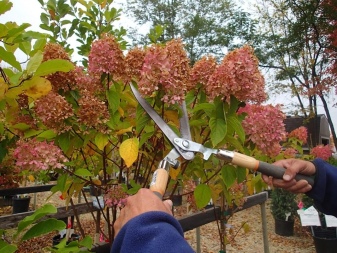
Preparing for winter
Since hydrangea belongs to heat-loving plants, and it has low winter hardiness, the plant must be protected from frost. Young representatives should be covered with fallen leaves, sawdust. Older cultures are bent to the ground, after which they are covered with roofing material. Protecting the culture from being blown away by the wind, it is recommended to press down the covering materials with bricks.

An adult hydrangia needs careful protection during the freezing period. In order to preserve the culture, the bushes are tied up, and then covered with lutrasil. It is also recommended to build a metal frame at a distance of 0.3 meters from the representative of the flora. This structure is a guarantee of hydrangea protection from severe frosts. If the heat is stable in springtime, all shelters can be removed.

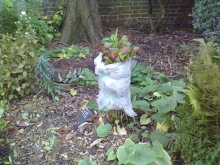

How to paint?
It's no secret that you can make a plant with blue, blue buds from a pink hydrangea, and a lilac plant from a red one. However, no one has yet succeeded in making a blue culture out of white. The change in the color of the inflorescences is facilitated by a change in the acidity of the soil: on alkaline soils they are pink, and on sour soils they are blue. The color change occurs as the plant matures.


After planting pink hydrangia, blue can only be seen after a few years.
To artificially stain the culture in a blue tint, you need to add a solution of aluminum or iron alum to the soil near the bush once every 14 days. A young representative will need 5 liters, and an adult 10.

Examples in landscape design
Hydrangea red is considered the leader among the plants that are used in landscape design. On a personal plot or in a city park, the culture should be planted alone. You can also use this representative of the flora as a hedge and a participant in a bright and beautiful composition.
Red hydrangia can be planted near evergreen blue spruces, junipers. Along the paths or not far from shady corners of the garden, you can plant hydrangeas along with barberries and herbaceous perennials.

For the secrets of the lush flowering of hydrangeas, see below.



































































The comment was sent successfully.